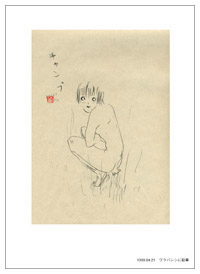


 |


launch interview with Kaoru Arima
Since 1997, Kaoru Arima has produced drawings on a daily basis, following the disciplined methodology of a diary. His supports vary from notebooks to plain paper to the pages of newspapers. His drawings are figurative and borrow from a wide range of sources, unfolding a complex and intricate sense of iconography: Priapus emerging from the back of a child centaur; a hallucinated hydrocephalous salary-man wearing nothing but a tie; a mushroom-headed genie brandishing an oversized amanita; a urinating angel; a mermaid flirting with a hairy devil; an anthropomorphic tree playing the deus ex machina; a man growing puppets out of his own arms. Distorted bodies with eccentric sexuality, twisted mythologies merging with underground icons, primal anxiety juxtaposed with absolute serenity, and sharp sarcasm next to naive poetry are elements animating the rather odd nature of these drawings. All of these images are drawn with a nervous line and occupy the center of the page, isolated on a white painted background when on newspaper. A very short text is embedded in the body of each drawing, providing a textual equivalent or complement to the visual messages. The texts themselves, as absurd as the drawings, reveal a delight in word play, puns, and the comedy of life. They provide an additional twist to the drawings, revealing a weird philosophical truth--a truth that is often critical of Japanese society, its fears, its fascinations, its beliefs, and its taboos. In an oblique way, his work seems to follow the poetic tradition of the haiku--very short poems appearing to be cute aphorisms yet informed by direct experience--and he merges national cultural references with philosophy and "zero-emotion" humor.
Arima feeds his practice from dual traditions: one deriving from a nonmodernist Zen Buddhist history, the other informed by conceptual art strategies that aim to systematically analyze and exhaust the temporal, spatial, and cultural parameters that constitute art and culture. The subversive dimension of his work stems from the fact that each of these languages produces a critique of the other without establishing a hierarchy of one over the other.
Arima runs a space called the Art Drug Center. Based in the remote location of Inuyama-City, this art center (which he considers part of his work as an artist) has become a necessary local link between communities and cultural projects. He has shown his work in numerous group shows in Japan, including Transit, Laforet Harajuku Kokura, Kitakyushu (2001); Contemporary Art 2001 at Yada Citizen Gallery, Nagoya (2001); and Let's Go to the Living Room at the Watari Museum of Contemporary Art in Tokyo (1998-1999). In 2000, the Fukugan Gallery in Osaka organized a solo exhibition of his work.
--Philippe Vergne











